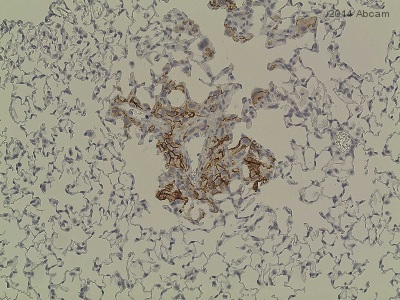Anti-L1CAM antibody [UJ127]
| Name | Anti-L1CAM antibody [UJ127] |
|---|---|
| Supplier | Abcam |
| Catalog | ab3200 |
| Prices | $398.00 |
| Sizes | 500 µl |
| Host | Mouse |
| Clonality | Monoclonal |
| Isotype | IgG1 |
| Clone | UJ127 |
| Applications | ICC/IF ICC/IF IHC-P IP WB |
| Species Reactivities | Human |
| Antigen | Homogenous suspension of 16 week human fetal brain |
| Description | Mouse Monoclonal |
| Gene | L1CAM |
| Conjugate | Unconjugated |
| Supplier Page | Shop |
Product images
Product References
EphB regulates L1 phosphorylation during retinocollicular mapping. - EphB regulates L1 phosphorylation during retinocollicular mapping.
Dai J, Dalal JS, Thakar S, Henkemeyer M, Lemmon VP, Harunaga JS, Schlatter MC, Buhusi M, Maness PF. Mol Cell Neurosci. 2012 Jun;50(2):201-10.
CHL1 promotes Sema3A-induced growth cone collapse and neurite elaboration through - CHL1 promotes Sema3A-induced growth cone collapse and neurite elaboration through
Schlatter MC, Buhusi M, Wright AG, Maness PF. J Neurochem. 2008 Feb;104(3):731-44. Epub 2007 Nov 6.
Biomarker discovery from pancreatic cancer secretome using a differential - Biomarker discovery from pancreatic cancer secretome using a differential
Gronborg M, Kristiansen TZ, Iwahori A, Chang R, Reddy R, Sato N, Molina H, Jensen ON, Hruban RH, Goggins MG, Maitra A, Pandey A. Mol Cell Proteomics. 2006 Jan;5(1):157-71. Epub 2005 Oct 8.
![ab3200 at a dilution of 1/1000, staining L1CAM (green; Alexa 488 secondary at 1/2000) on 30µm coronal rat brain tissue sections in free floating IHC (see protocol link for detailed description). Images showing neuron body, cytoplasm and axon labeling: [A] neuron; 40x objective [B] neuron and axons; 40x objective and [C] punctate cytoplasmic labeling. Images coloured in Photoshop.NB: No labeling observed following omission of primary antibody.Sections were viewed using an Axioplan 2 Imaging microscope (Imaging Associates) fitted with 10x, 20x and 40x Plan-Neofluorobjectives (Zeiss, Germany) and images were taken using a AxioCam Hrm digital camera (Zeiss, Germany) and AxioVision software (Imaging Associates).](http://www.bioprodhub.com/system/product_images/ab_products/2/sub_3/14466_ab3200_1.jpg)
![Anti-L1CAM antibody [UJ127] (ab3200) at 1 µg/ml + Brain (Human) Tissue Lysate - adult normal tissue (ab29466) at 10 µgSecondaryGoat Anti-Mouse IgG H&L (HRP) preadsorbed (ab97040) at 1/5000 dilutiondeveloped using the ECL techniquePerformed under reducing conditions.Observed band size : 230 kDa (why is the actual band size different from the predicted?)Additional bands at : 75 kDa. We are unsure as to the identity of these extra bands.Exposure time : 8 minutes L1CAM contains an exstensive number of potential glycosylation sites (SwissProt) which may explain its migration at a higher molecular weight than predicted.](http://www.bioprodhub.com/system/product_images/ab_products/2/sub_3/14467_L1CAM-Primary-antibodies-ab3200-2.jpg)
